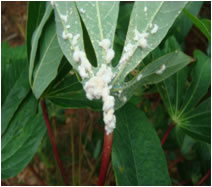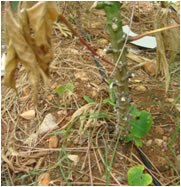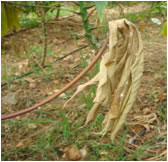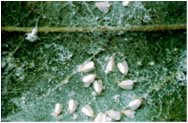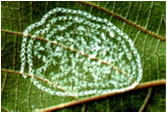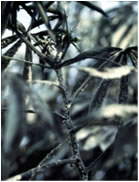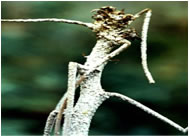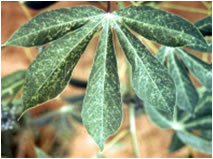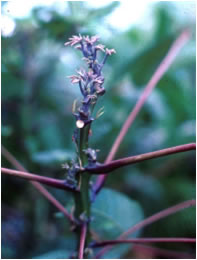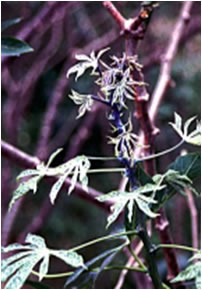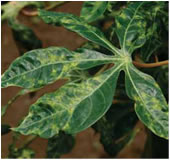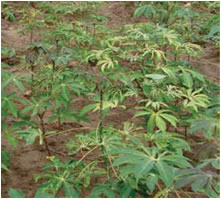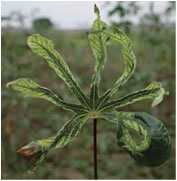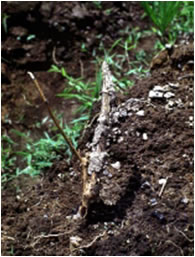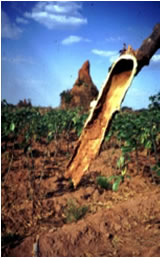
| Planting and vegetative growth stage |
| Insect Pest | Symptoms |
Advisory |
Image |
Mealybug: Phenacoccus manihoti
|
• Nymphs and adults sucks the sap from tapioca leaves and shoots tip. • Reduction in lengths of internodes and causes the leaves to clump together into "bunchy tops". • The pest also distorts the stems, dries up the leaves. • Defoliation of plants at severe infestation. • The damage is more severe in the dry than in the wet season.
|
Cultural method • Monitoring to detect early presence of the mealy bug. • Pruning and burning of infested branches. • Removal and burning of crop residues. • Removal of weeds/alternate host plants like Hibiscus, Parthenium etc. in and nearby crop. • Avoid the movement of planting material from infested areas to other areas. • Avoiding flood irrigation. • Prevention of the movement of ants and destruction of already existing ant colonies. • Cleaning of farm implements before moving it to the uninfested crop. • Don't stock the proplagules of mealy bug infected crop for next season planting. • Before planting, setts, soak the setts for 1 hr in dichlorvos (76%EC @10 ml/litre of water) to disinfest the mealy bugs. • The stock near the tapioca fields acts as a reservoir of mealybug, so dust with chlorpyriphos 1.5% or malathion 5% DP around the stock to check the movement of crawlers as well as ants from/to the stock. Biological method • Natural enemies namely, Cryptolaemus montrouzieri, ladybird beetles, lacewings,hover flies, Scymnus sp. and certain hymenopteran and dipteran parasitoid conserved for reducing the mealybug population. • In the nature, lepidopteran predator, Spalgis epius (Lycaenidae) act as a dominant predator, feeds efficiently on the ovisacs, nymphs and adult of mealybug. Chemical method • Locate ant colonies and destroy them by drenching of chlorpyriphos 20 EC @ 2 .0 ml/litre of water. • Spot application of insecticide immediately after noticing mealybug on some plants in the crop field. • Use botanical insecticides such as neem oil (1 to 2%), NSKE (5%), or Fish Oil Rosin Soap (25g/litre of water). • Apply recommended chemical insecticides as the last resort such as profenophos 50 EC (2 ml/litre), chlorpyriphos 20 EC (2ml/litre), buprofezin 25 EC (2 ml/litre), dimethoate 30 EC (2 ml/litre), thiomethoxam 25 WG (0.6 g/litre), imidacloprid 17.8 SL (0.6 ml/litre). |
|
| Tapioca leaves damaged by mealybug | |||
|
|||
| Spiraling whitefly: Aleurodicus dispersus | • The spiraling whitefly sucks sap from tapioca leaves. • As it feeds, it secretes large amounts of honeydew which supports the growth of black mold on the plant. • The blackened leaves dry up and drop.
|
Cultural method • Remove alternate host: Abutilon indicum Mechanical method • Set up yellow sticky trap Chemical method • Spray phosalone 35 EC at 2.5 l/ha or quinalphos 25 EC at 2.0 l/ha or triazophos 40 EC 2.0 l/ha |
|
| Whitefly: Bemisia tabaci |
• Nymphs and adults flies suck sap from the leaves, but this does not cause physical damage to the plant. • As they feed, the insects inject the plant with viruses which cause tapioca mosaic disease. • This is the main reason why the insect is an important tapioca pest. |
1. Use disease free material (ie., stems) for planting 2. Spray dimethoate ( 1.7 ml / lit ) to check the vectors. |
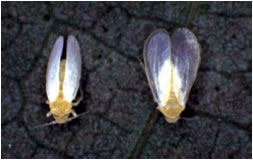 |
| Tapioca white scale: Found mainly on tapioca stem surfaces. The females are wingless, firmly attached to the stems, and covered with white material. The males have wings. Method of spread: Males of the tapioca white scale can fly. However, the pest spreads mainly by wind and the transport and planting of infested stem cuttings. |
The insect sucks sap from tapioca stems. This causes the stems to lose a lot of water and die. | White scale on tapioca stem
|
| Non Insect pest | Symptoms |
Advisory |
Image |
Tapioca green mite and Red mite: • Under field condition mites can be observed through hand lens. • Green mite, lives on under surface of young tapioca leaves. • Mites are wingless, very tiny, and appear as specks to the naked eye. • The nymphs (immature mites) are green in color and turn yellowish as they get older. • Red mites also occur on tapioca, mostly on the older leaves. |
• It sucks sap from tapioca leaves and shoot tips. • It causes tiny yellow chlorotic spots the size of pin pricks, on the upper leaf surfaces. • Observers should not confuse chlorotic spots caused by the pest with the chlorotic patches of tapioca mosaic disease. • Young leaves attacked by tapioca green mites become small and narrow. • The pest kills the terminal leaves and as these drop the shoot tip looks like a "candlestick". • Crop damage more severe in the dry than in the wet season. Method of spread: Tapioca green mite is tiny, light, and easily blown by wind from plant to plant. Also, it survives on stem surfaces and is spread by being carried by farmers on tapioca stem planting materials. |
• Under field conditions light infestation of mites can be controlled effectively by spraying the crop with water at 10 days interval from the onset of mite infestation. • In the case of very severe infestation, spray 0.05% dimethoate or methyl demeton at monthly intervals from the time of appearance of mites. |
|
|
| Diseases | Symptoms |
Management |
Image |
Mosaic disease: Vector white fly Affected plant stages: Seedling to reproductive stages
|
• White or pale-yellow or pale-green spots on infected leaves.
|
Cultural method: • Use of cassava resistant varieties or diseased-free planting materials.
• Removal of infected plants
• Maintain field sanitation
Chemical method:
• Spray dimethoate ( 1.7 ml / lit ) to check the vectors. |
|
| Maturity and Harvesting stage |
| Insect Pest | Symptom of Damage |
Advisory |
Image |
| Stem and root feeders Termites |
• Termites chew and eat stem cuttings. • Affected stem cuttings grow poorly, die and rot. • In older Plants, termites chew and enter the stems. • This weakens the stems and causes them to break easily. • Termite damage occurs mostly in the dry season. |
• Sprinkle dust of carbaryl 10% or chlorpyrifos in the mounds prior to planting. | |
| Tapioca stem cutting destroyed by termites and Stem of a mature tapioca plant chewed off by termites (termite nest in background, center) | |||
|
![]()
Focus Districts
Gallery
